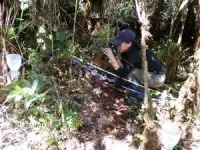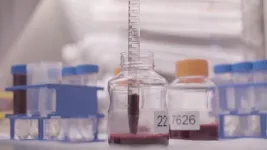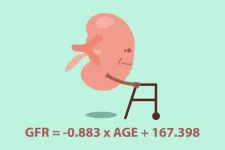(Press-News.org) Since the 1950s, scientists have used radio waves to uncover the molecular “fingerprints” of unknown materials, aiding in tasks as varied as scanning the human body with MRI machines and detecting explosives at airports.
These methods, however, rely on signals averaged from trillions of atoms, making it impossible to detect tiny variations between individual molecules. Such limitations hinder applications in fields like protein research, where small differences in shape control functionality and can determine the difference between health and disease.
Sub-Atomic Insights
Now, engineers at the University of Pennsylvania School of Engineering and Applied Science (Penn Engineering) have utilized quantum sensors to realize a groundbreaking variation of nuclear quadrupolar resonance (NQR) spectroscopy, a technique traditionally used to detect drugs and explosives or analyze pharmaceuticals.
Described in Nano Letters, the new method is so precise that it can detect the NQR signals from individual atoms — a feat once thought unattainable. This unprecedented sensitivity opens the door to breakthroughs in fields like drug development, where understanding molecular interactions at the atomic level is critical.
“This technique allows us to isolate individual nuclei and reveal tiny differences in what were thought to be identical molecules,” says Lee Bassett, Associate Professor in Electrical and Systems Engineering (ESE), Director of Penn’s Quantum Engineering Laboratory (QEL) and the paper’s senior author. “By focusing on a single nucleus, we can uncover details about molecular structure and dynamics that were previously hidden. This capability allows us to study the building blocks of the natural world at an entirely new scale.”
An Unexpected Discovery
The discovery stemmed from an unexpected observation during routine experiments. Alex Breitweiser, a recent doctoral graduate in Physics from Penn’s School of Arts & Sciences and the paper’s co-first author, who is now a researcher at IBM, was working with nitrogen-vacancy (NV) centers in diamonds — atomic-scale defects often used in quantum sensing — when he noticed unusual patterns in the data.
The periodic signals looked like an experimental artifact, but persisted after extensive troubleshooting. Returning to textbooks from the 1950s and ‘60s on nuclear magnetic resonance, Breitweiser identified a physical mechanism that explained what they were seeing, but that had previously been dismissed as experimentally insignificant.
Advances in technology allowed the team to detect and measure effects that were once beyond the reach of scientific instruments. “We realized we weren’t just seeing an anomaly,” Brietweiser says. “We were breaking into a new regime of physics that we can access with this technology.”
Unprecedented Precision
Understanding of the effect was further developed through collaboration with researchers at Delft University of Technology in the Netherlands, where Breitweiser had spent time conducting research on related topics as part of an international fellowship. Combining expertise in experimental physics, quantum sensing and theoretical modeling, the team created a method capable of capturing single atomic signals with extraordinary precision.
“This is a bit like isolating a single row in a huge spreadsheet,” explains Mathieu Ouellet, a recent ESE doctoral graduate and the paper’s other co-first author. “Traditional NQR produces something like an average — you get a sense of the data as a whole, but know nothing about the individual data points. With this method, it’s as though we’ve uncovered all the data behind the average, isolating the signal from one nucleus and revealing its unique properties.”
Deciphering the Signals
Determining the theoretical underpinnings of the unexpected experimental result took significant effort. Ouellet had to carefully test various hypotheses, running simulations and performing calculations to match the data with potential causes. “It’s a bit like diagnosing a patient based on symptoms,” he explains. “The data points to something unusual, but there are often multiple possible explanations. It took quite a while to arrive at the correct diagnosis.”
Looking ahead, the researchers see vast potential for their method to address pressing scientific challenges. By characterizing phenomena that were previously hidden, the new method could help scientists better understand the molecular mechanisms that shape our world.
This study was conducted at the University of Pennsylvania School of Engineering and Applied Science and supported by the National Science Foundation (ECCS-1842655, DMR-2019444). Additional support came from the Natural Sciences and Engineering Research Council of Canada, through a Ph.D. Fellowship awarded to Ouellet, and from IBM, through a Ph.D. Fellowship awarded to Breitweiser.
Additional co-authors include Tzu-Yung Huang, formerly a doctoral student in ESE within Penn Engineering, now of Nokia Bell Labs, and Tim H. Taminiau at Delft University of Technology.
END
New quantum sensing technology reveals sub-atomic signals
Detection of individual nuclei opens doors in drug development, protein folding
2025-01-06
ELSE PRESS RELEASES FROM THIS DATE:
Significant funding to ensure personalized treatments that work for rheumatoid arthritis
2025-01-06
In recent years treatment with powerful biologic and targeted synthetic therapies has changed the landscape for arthritis, but currently finding the right treatment for each person is a matter of trial and error. Only a proportion of patients with inflammatory arthritis respond to each expensive therapy, which results in unnecessary treatment and a long and often frustrating journey for patients, not to mention significant cost to the NHS.
University of Birmingham researchers have just been awarded £3.5 million funding from Johnson & Johnson to investigate ...
CryoSCAPE: Allen Institute scientists develop ‘suspended animation’ technique for blood draws that will aid research for underserved populations
2025-01-06
By Rachel Tompa, Ph.D
Your blood is a delicate mixture. Researchers and clinicians often use blood to learn what’s going on inside our bodies, in part because siphoning off a tube of blood is easier and less painful than taking biopsies of an internal organ.
But in some cases, it turns out that blood can be very different outside our bodies. When it comes to certain emerging research techniques, the clock starts ticking as soon as your blood hits the tube. As little as six to eight hours later, some aspects of your blood’s ...
Prime apple growing areas in US face increasing climate risks
2025-01-06
VANCOUVER, Wash. – Some of the most productive apple regions in America are facing big challenges from a changing climate, according to a Washington State University study.
Researchers analyzed over 40 years of climate conditions that impact the growth cycle of apple trees from bud break and flowering through fruit development, maturation and color development.
While many growing areas are facing increased climate risks, the top three largest apple producing counties in the U.S. were among the most impacted: Yakima in Washington, Kent in Michigan and Wayne ...
Extended Paxlovid may help some people with long COVID
2025-01-06
An up-close look at how patients respond to the drug at different times and doses adds nuance to a recent finding that Paxlovid does not work for long Covid.
An extended course of Paxlovid appears to help some patients with long Covid, according to a case series by UC San Francisco researchers that suggests this treatment option holds promise for some of those struggling with debilitating symptoms.
These results are at odds with recent research that has failed to show the antiviral can alleviate persistent symptoms of the disease. The authors said more study is needed to find out which patients may benefit from the drug and how long it should be given.
The ...
Media coverage of civilian casualties in allied countries boosts support for U.S. involvement
2025-01-06
From photographs of decimated buildings to military and civilian casualty counts to narratives of suffering, news media bring information about foreign conflicts to American audiences. But does this coverage actually affect public opinion about whether and how the United States should be involved in a conflict? Does it influence what Americans think about the U.S. providing military, diplomatic, and economic aid to foreign nations?
A new paper from researchers at the Annenberg Public Policy Center (APPC) of the University of Pennsylvania examines these questions and finds that media coverage of civilian casualties increases public support for U.S. involvement in conflicts by evoking empathy ...
Marked decrease in Arctic pressure ridges
2025-01-06
In the Arctic, the old, multiyear ice is increasingly melting, dramatically reducing the frequency and size of pressure ridges. These ridges are created when ice floes press against each other and become stacked, and are a characteristic feature of Arctic sea ice, an obstacle for shipping, but also an essential component of the ecosystem. In a recently released study in the journal Nature Climate Change, experts from the Alfred Wegener Institute report on this trend and analyse observational data from three decades of aerial surveys.
Satellite data from the last three decades documents the dramatic changes in Arctic sea ice due to climate change: the area covered in ice in summer ...
Age matters: Kidney disorder indicator gains precision
2025-01-06
Annual health checkups regularly include urine tests that serve several purposes, including checking for symptoms of kidney disease. The presence of albumin in the urine is one indicator as is glomerular filtration rate. In diabetic nephropathy, albuminuria first appears, leading to excessive filtration and eventually a decrease in GFR.
In the elderly, however, excessive filtration cannot be detected due to age-related GFR decline. To accurately assess GFR, Osaka Metropolitan University researchers have come up with ...
New guidelines for managing blood cancers in pregnancy
2025-01-04
A new set of guidelines has been developed to assist with the diagnosis and expert management of serious blood cancers in pregnancy.
About 12.5 pregnancies per 100,000 are affected by blood cancers such as acute leukaemia and aggressive lymphomas, and their incidence has been rising.
Between 1994 and 2013, they increased by 2.7 per cent a year, due to factors including women having children later, improved diagnostic techniques, and increased health system engagement.
An Australian working group has now published a new position statement in the latest edition of The Lancet Haematology, based on current evidence and expert consensus.
It ...
New study suggests RNA present on surfaces of leaves may shape microbial communities
2025-01-03
Biologists at Indiana University Bloomington have shown that the surfaces of plant leaves are coated with a diverse array of RNA molecules. The finding suggests that the RNA present on the leaf surface may play a role in shaping the microbial communities that inhabit them, potentially influencing plant health and interactions within their environment, according to a new study.
The study, Diverse plant RNAs coat Arabidopsis leaves and are distinct from apoplastic RNAs, was published Jan. 3, 2025 in the Proceedings of the National Academy of Sciences. The first authors are Lucía ...
U.S. suffers from low social mobility. Is sprawl partly to blame?
2025-01-03
Urban sprawl is not just unsightly. It could also be impeding intergenerational mobility for low-income residents and reinforcing racial inequality, according to a series of recent studies led by a University of Utah geographer.
One analysis of tract-level Census data co-authored with a former economics graduate student in the U’s College of Social & Behavioral Science found that people who grew up in high-sprawl neighborhoods have less earning potential than those who grew in denser neighborhoods.
“For adults, jobs are harder to access in more sprawling neighborhoods,” said Kelsey Carlston, now an assistant professor of economics at Gonzaga University. “If we ...
LAST 30 PRESS RELEASES:
Scalable and healable gradient textiles for multi‑scenario radiative cooling via bicomponent blow spinning
Research shows informed traders never let a good climate crisis go to waste
Intelligent XGBoost framework enhances asphalt pavement skid resistance assessment
Dual-function biomaterials for postoperative osteosarcoma: Tumor suppression and bone regeneration
New framework reveals where transport emissions concentrate in Singapore
NTP-enhanced lattice oxygen activation in Ce-Co catalysts for low-temperature soot combustion
Synergistic interface engineering in Cu-Zn-Ce catalysts for efficient CO2 hydrogenation to methanol
COVID-19 leaves a lasting mark on the human brain
Scientists use ultrasound to soften and treat cancer tumors without damaging healthy tissue
Community swimming program for Black youth boosts skills, sense of belonging, study finds
Specific depressive symptoms in midlife linked to increased dementia risk
An ‘illuminating’ design sheds light on cholesterol
Who is more likely to get long COVID?
Study showcases resilience and rapid growth of “living rocks”
Naval Research Lab diver earns Office of Naval Research 2025 Sailor of the Year
New Mayo-led study establishes practical definition for rapidly progressive dementia
Fossil fuel industry’s “climate false solutions” reinforce its power and aggravate environmental injustice
Researchers reveal bias in a widely used measure of algorithm performance
Alcohol causes cancer. A study from IOCB Prague confirms damage to DNA and shows how cells defend against it
Hidden viruses in wastewater treatment may shape public health risks, study finds
Unlock the power of nature: how biomass can transform climate mitigation
Biochar reshapes hidden soil microbes that capture carbon dioxide in farmland
Reducing saturated fat intake shows mortality benefit, but only in high-risk individuals
Manta rays create mobile ecosystems, study finds
Study: Mixed results in using lipoic acid to treat progressive multiple sclerosis
Norbert Holtkamp appointed director of Fermi National Accelerator Laboratory
New agentic AI platform accelerates advanced optics design
Biologists discover neurons use physical signals — not electricity — to stabilize communication
Researchers discover that a hormone can access the brain by hitchhiking
University of Oklahoma researcher awarded funding to pursue AI-powered material design
[Press-News.org] New quantum sensing technology reveals sub-atomic signalsDetection of individual nuclei opens doors in drug development, protein folding






